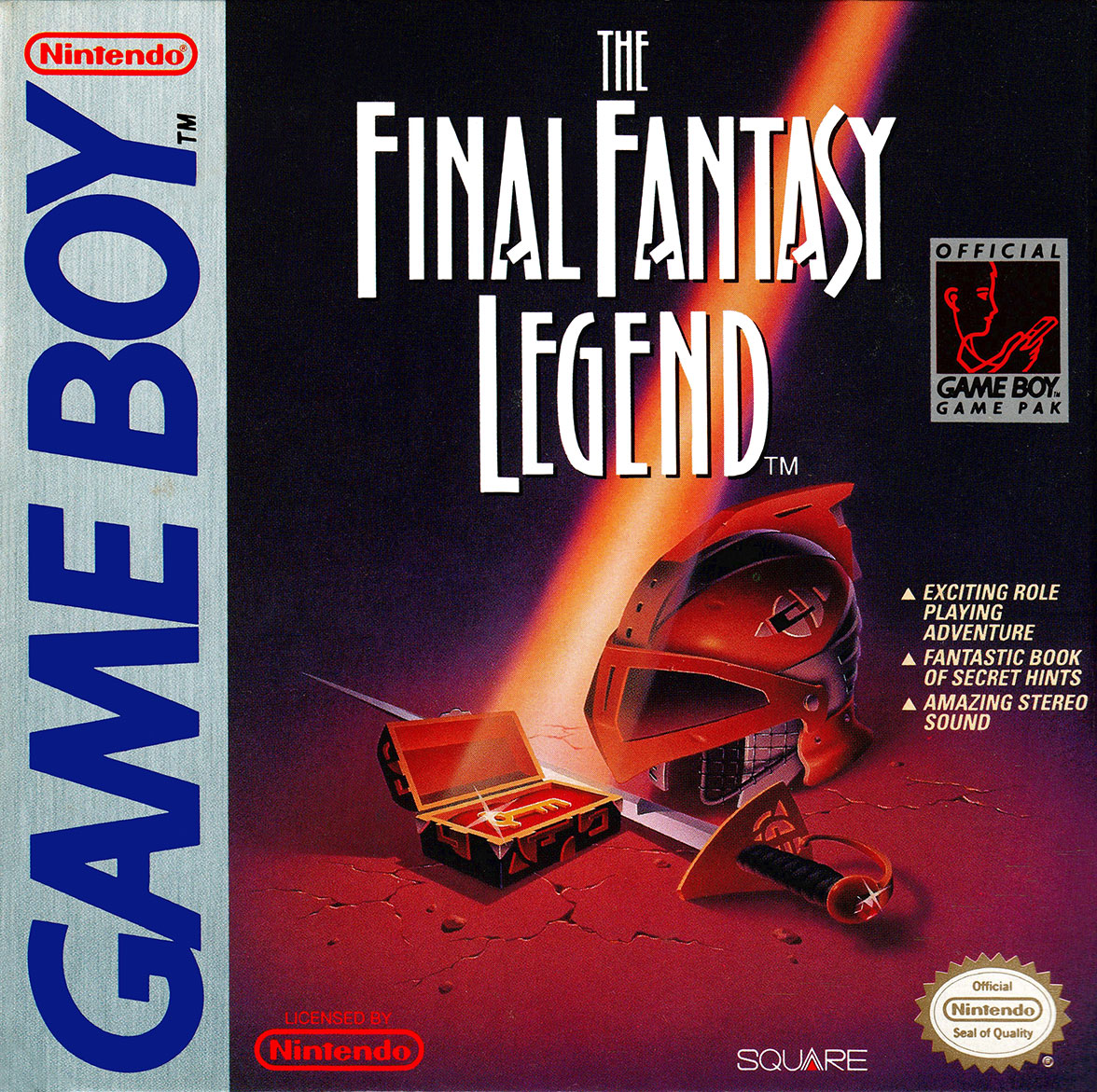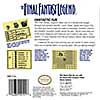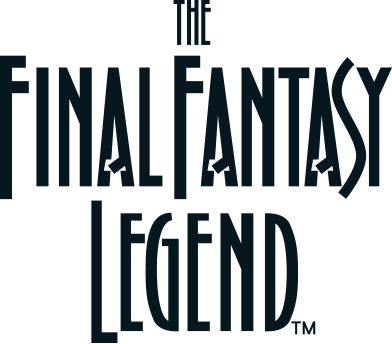
 About Final Fantasy Legend(SaGa 1)
About Final Fantasy Legend(SaGa 1)
History
Final Fantasy Legend
Final Fantasy Legend (known in Japan as “Makai Toushi SaGa”) is a traditional RPG developed and published by Square for the original Game Boy back in 1989. This marked the debut entry in the long-running SaGa series! It was the first RPG released for the Game Boy. The game was designed by Akitoshi Kawazu, known for his unconventional approach to character growth systems, which would become a hallmark of the series.
Final Fantasy Legend follows a party of adventurers climbing a mysterious tower to reach Paradise. The game blends multiple genres: science fiction and fantasy elements. When you start a new game, you choose from humans, mutants, and monsters. Each character type has their unique growth systems. Humans, for example, gain strength through purchased stat upgrades. Mutants evolve organically through battle. Monsters change form by consuming “meat” dropped by enemies. This emphasis on player-driven customization and non-linear progression distinguished the title from other RPGs of its era.
The following is on the back of the box:
“Final Fantasy Legend takes you on a sensational voyage through four fantastic worlds: land, ocean, space and a future city. You and your band of warriors seek out to overpower Zombies, Goblins and dreadful monsters hidden along the way. Secret clues lead you to the exotic weapons and treasure you'll need to stay alive. It takes you all the spirit and cunning you can muster to claim victory. Once you've started there's no turning back. Are you daring enough?”
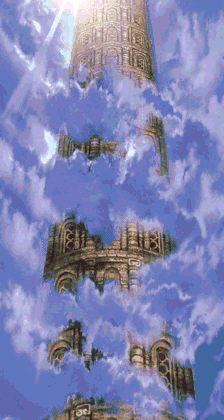 In 1998, Sunsoft acquired the license for Final Fantasy Legend and re-released it on the Game Boy in North America. Nothing was changed or added to the game, aside from Sunsoft's logo on the box. It was simply a re-distribution done on behalf of Squaresoft.
In 1998, Sunsoft acquired the license for Final Fantasy Legend and re-released it on the Game Boy in North America. Nothing was changed or added to the game, aside from Sunsoft's logo on the box. It was simply a re-distribution done on behalf of Squaresoft.
It can be a little confusing following the correct naming of every game in the SaGa series. For example, did you know SaGa Frontier is SaGa 7? Here's what's what in the series to make things clearer:
• Final Fantasy Legend (Game Boy) a.k.a. SaGa 1
• Final Fantasy Legend (Game Boy) a.k.a. SaGa 2
• Final Fantasy Legend (Game Boy) a.k.a. SaGa 3
• Romancing SaGa (SNES) a.k.a. SaGa 4
• Romancing SaGa 2 (SNES) a.k.a. SaGa 5
• Romancing SaGa 3 (SNES) a.k.a. SaGa 6
• SaGa Frontier (Playstation) a.k.a. SaGa 7
• SaGa Frontier 2 (Playstation) a.k.a. SaGa 8
• Unlimited SaGa a.k.a. SaGa 9
Makaitoushi SaGa
“Makai Toushi SaGa” is Final Fantasy Legend's Japanese name. In 2002, Squaresoft released a remade version of Makai Toushi SaGa for the Wonderswan Color (Game Boy Advance's petty competition in Japan). They totally renovated the game and upgraded its quality to something more along the lines of the Super Nintendo.
Unfortunately, Makai Toushi SaGa was never released outside of Japan. This was mostly due to the fact that the Wonderswan Color was not released outside of Japan either. However, in March 2011 (9 years after Makai Toushi's SaGa's release), “Tower Reversed” released a complete English translation for the game! SaGa fans rejoiced! You can download the English patch from my Downloads.
Collection of SaGa
“Collection of SaGa: Final Fantasy Legend” is a compilation of the first three titles in the SaGa series. It was released for Nintendo Switch in December 2020, with later versions for iOS, Android, and PC. The collection features Final Fantasy Legend 1-3, presented with faithful emulation and minor quality-of-life enhancements. Features include a high-speed mode, adjustable screen layouts, and save state functionality.
Battle System
Battles are random encounters that take place on a separate battle screen. The system is menu-driven and resembles early Final Fantasy titles but has some unique mechanics due to its mix of Humans, Mutants, and Monsters.
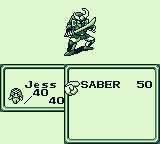 “Saber” has 50 charges
“Saber” has 50 charges
Weapons & Items
- Weapons in this game have limited uses. A sword might have 50 charges, a gun 99, etc. Once the uses hit zero, the weapon breaks.
- This forces you to manage resources carefully rather than just buying one weapon and keeping it forever.
- Armor and accessories don’t break and provide permanent stat boosts.
Character Types
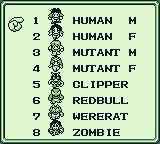 Character selection
Character selection
- Humans - Depend on weapons and items. Can’t use magic; increase stats by buying potions.
- Mutants - Gain random abilities and spells after battle. Their stats may increase randomly after fights.
- Monsters - Use monster abilities instead of equipment. Eating meat dropped by enemies transforms them into different monsters.
I talk more about the playable characters on the Characters page.
Tips & Strategy
When you start Final Fantasy Legend, you choose one of eight characters: a male human, female human, male mutant, female mutant, or one of four monsters (Clipper, Red Bull, Wererat, Zombie). While a female mutant lead is a great pick (mutants scale well) here are your options:
 Character selection
Character selection
Character Options
- Mutants (recommended for beginners): Gain random stat increases and spells after battles. A team of mutants becomes strong with minimal grinding.
- Humans (for controlled builds): Improve only via purchased potions (STR, AGI, HP). Costly, but lets you tailor growth precisely.
- Monsters (advanced): Evolve by eating meat from enemies. Very flexible, but requires knowledge of evolution chains.
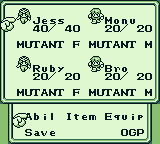 A party of all mutants
A party of all mutants
Recommended Starting Party
Choose one female mutant as your main character and recruit three additional mutants. This party grows quickly without heavy spending on potions.
Early Game Strategy
- Prioritize armor first: Survivability matters more than raw damage early on.
- Use the guild to swap: Unhappy with a recruit? Replace them anytime.
- Be thrifty with healing: Inns and Cure spells add up. Rest only when needed.
- Do a short grind: 5–10 minutes in the opening area funds better gear and smooths the first dungeon.
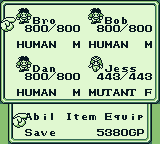 3 humans and 1 mutant
3 humans and 1 mutant
Endgame Preparation
- Human swap plan: Before entering The Tower, replace three mutants with male humans. Buy STR/AGI/HP potions. Raise HP toward 600.
- Gear up: Equip top-tier armor; carry multi-use, high-impact weapons (e.g., Chainsaws, Guns, powerful Swords). Remember weapons have limited uses, so bring extras.
- Healing: Ensure your remaining mutant has ample Cure charges for the long climb.
- Crowd control: Bring some multi-target options (e.g., Nunchaku, Whips) for groups.
Optional Monster Tips
- Farm meat in higher-level areas to jump into stronger monster forms earlier than intended.
- Target enemies known for powerful meat drops to reach Ogres/Dragons-style forms for a big power spike.
My Opinion
I love this game so much! It's such a fun game. It really shows off what made early RPGs so charming. Don't let its simplicity fool you - this is a game that rewards patience and curiosity. If you enjoy classic RPGs with minimal handholding, you'll appreciate Final Fantasy Legend's text-driven storytelling, strategic combat, and charming 8-bit, four-color visuals. It's a game that feels like a time capsule of the early days of portable gaming. But yet, it still has a unique flavor that sets it apart.
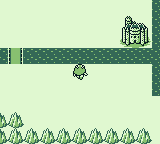 Wandering around aimlessly.
Wandering around aimlessly.“Oh, a castle. I guess I should enter?”
When I first got my hands on Final Fantasy Legend, I had already played and thoroughly enjoyed Final Fantasy Legend 3. That was actually my very first Game Boy RPG. Finding a copy of the original was exciting! It felt like I was uncovering the roots of something I already loved. I remember those first moments: the game dropped me into its world with little explanation. I had to figure out what to do through exploration and trial and error. The battle system felt completely different from what I was used to in Final Fantasy Legend 3, which made it both challenging and fascinating to learn.
Final Fantasy Legend doesn't hold your hand, and that's part of its appeal. It expects you to experiment, think critically, and embrace its quirks. That sense of mystery is what makes Final Fantasy Legend so memorable for me. It's more than just nostalgia - it’s a genuinely interesting piece of RPG history that still feels rewarding to play today.
